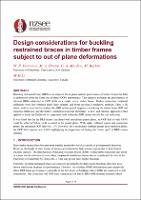Design Considerations for Buckling Restrained Braces in Timber Frames Subject to Out of Plane Deformations

Download
Date
2023-04-19Authors
Dorrance, William
Huang, Matthew
MacRae, Gregory
Bashiri, Mehdi
Li, Minghao
Metadata
Show full item recordAbstract
The introduction of using steel buckling restrained braces (BRBs) has proven to greatly improve the in-plane seismic performance of timber structures. However, little is understood about the performance of BRBs subject to out of plane (OOP) deformations. This research evaluates the performance of chevron BRBs subjected to OOP drifts in a single storey timber frame. A 3D elastic analysis was used to analyse the global response of the BRB system. Finite element models and beam on elastic foundation method was used to model the rotational stiffness of the timber connections. The fixity of the brace-to-frame connection was based on the timber beam torsional stiffness and timber connection rotational stiffnesses summated as springs in series. For combined actions (OOP moment and axial) analysis, an amplification factor of 1.3 was applied to the in-plane strength to account for out-of-plane deformations increasing the brace axial strength. The unstiffened BRB only achieved an OOP drift of 0.83% when assessing for combined actions due to its high flexibility. A highly stiffened BRB with rectangular stiffeners on the gusset and connection plates achieved a maximum OOP drift of 1.5% when assessing for combined actions. At higher drifts, gusset plate yielding was likely to occur due to the high stiffness of the stiffened gusset plates attracting large OOP moments. A moderately stiffened BRB with reduced size rectangular stiffeners had more optimal performance and achieved the highest OOP drift of 1.66%. This highlighted the importance of finding the “sweet spot” in BRB system OOP stiffness.
